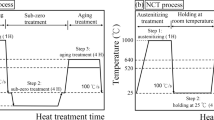Abstract
The effects of grain size on magnetic properties of nonoriented electrical steel sheets were investigated at the commercial power of frequency (50 Hz). The permeability, magnetic induction, and core loss of test specimens were optimal at their intermediate grain sizes. (LC) core loss W15/50 of Epstein specimens was minimum at a grain diameter of approximately 150 μm, regardless of the silicon content. A study of the relationship between magnetic properties and grain size of ring specimens showed that core loss, magnetic induction, and ac permeability were optimal at larger grain diameters in a weak magnetic field and at smaller grain diameters in a strong magnetic field. It was found that magnetic induction and ac permeability tended to improve at large grain diameters in the irreversible magnetization range and at small grain diameters in the rotation magnetization range.
Similar content being viewed by others
References
W.E. Ruder, U.S. Patent 1,110,010.
T.D. Yensen, Trans. AIEE, 43, pp. 145–175, 1924.
T.D. Yensen and N.A. Ziegler, Trans. ASM, 23, pp. 556–576, 1935.
T.D. Yensen and N.A. Ziegler, Trans. ASM, 24, pp. 337–358, 1936.
ASTM Standard A 596-69 (Reapproved 1979).
S. Chikazumi, inPhysics of Ferromagnetism, pp. 174–175, Syokabo, Tokyo, 1962.
P.L. Charpentier and J.H. Bucher,Mechanical Working and Steel Processing, 10, pp. 61–98, AIME, 1972.
I.D. Zaydman and L.V. Mironov,Fiz. Metal. Metalloved., 35, No. 4, pp. 844–848, 1973.
M. Candiotti and G. Rocci, BOLLETTINO TECHNICO FINSIDER, No. 362, pp. 265–273 1977.
S. Taguchi,in Electrical Steel Sheets, ed. S. Taguchi, p. 33, Nippon Steel Corp., Tokyo, 1979.
R.R. Judd and K.E. Blazek, inEnergy Efficient Electrical Steels, ed. A.R. Marder and E.T. Stephenson, pp. 147–155, TMS-AIME, 1981.
H. Shimanaka, Y. Ito, T. Irie, K. Matsumura, H. Nakamura, and Y. Shono, inEnergy Efficient Electrical Steels, ed. A.R. Marder and E.T. Stephenson, pp. 193–204, TMS-AIME, 1981.
F. Böiling, H. Pottgiesser, and K. Schmidt, Stahl u. Eisen, 102, pp. 833–837, 1982.
K. Matsumura and B. Fukuda, IEEE Trans. Mag., MAG-20, pp. 1533–1538, 1984.
P.K. Rastogi and G. Lyudkovsky, IEEE Trans Mag.,MAG-20, p. 1539–1541, 1984.
K. Honma, T. Nozawa, H. Kobayashi, Y. Shimoyama, I. Tachino, and K. Miyoshi, IEEE Trans. Magn.,MAG-21, pp. 1903–1908, 1985.
E.T. Stephenson, and A.R. Marder, IEEE Trans. Mag.,MAG-22, pp. 101–105, 1986.
F. Böiling, M. Espenhahn, K. Günther, M. Hastenrath, and H. Huneus, Stahl u. Eisen,107, pp. 1119–1124, 1987.
N. Yurioka, T. Sakai, and O. Honjyou, Japanese Patent Toku-kou-shou 48-19048, 1973.
Author information
Authors and Affiliations
Rights and permissions
About this article
Cite this article
Shiozaki, M., Kurosaki, Y. The effects of grain size on the magnetic properties of nonoriented electrical steel sheets. J. Materials Engineering 11, 37–43 (1989). https://doi.org/10.1007/BF02833752
Issue Date:
DOI: https://doi.org/10.1007/BF02833752




